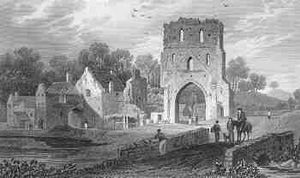Pill Priory facts for kids
Quick facts for kids Pill Priory, Tironensian Monastery (ruins) |
|
|---|---|
 |
|
| Religion | |
| Affiliation | Catholicism Benedictine |
| Region | Milford Haven, Wales |
| Ecclesiastical or organizational status | Private |
| Location | |
| Location | Milford Haven, South Wales, United Kingdom |
| Architecture | |
| Founder | Adam de la Roche |
| General contractor | Tironensian monks |
| Completed | Second half, 12th century |
| Specifications | |
| Height (max) | 10 metres (33 ft) |
| Materials | Old Red Sandstone, Carboniferous Limestone |
Pill Priory is the ruined home of a group of Tironian monks. It was built near Milford Haven, Pembrokeshire, in South West Wales. This historic site was founded in the late 12th century.
Contents
What is a Priory?
A priory is a type of monastery. It is a place where monks or nuns live together. They follow strict religious rules. Pill Priory was a "daughter house" of St Dogmaels Abbey. This means it was set up by monks from St Dogmaels. St Dogmaels Abbey was a larger monastery for the Tironensian order. The Tironensians were a special group of Benedictine monks. They followed a reformed, stricter way of life. Other daughter houses of St Dogmaels were on Caldey Island in Wales and Glascarrig in Ireland.
The Monks of Pill Priory
Pill Priory was started by the Roche family. They lived in the area and owned Roch Castle. Adam de la Roche founded the priory. This happened just a few years after St Dogmaels Abbey was built. Historians think it was founded between 1160 and 1190.
The priory was dedicated to two important figures. These were the Blessed Virgin Mary and St Budoc. There was also an older chapel nearby dedicated to St Budoc. It is now called "St Botolph".
The community of monks at Pill Priory was always quite small. Records show there were only five monks living there in 1534. By 1536, there were only four.
The End of the Priory
In 1536, a big change happened in England and Wales. This was called the Dissolution of the Monasteries. King Henry VIII decided to close down many monasteries. This included St Dogmaels Abbey and its daughter houses, Pill Priory and Caldey. Monasteries with a value of less than £200 were closed first.
Pill Priory was valued at about £52 each year after costs. This was less than £200, so it was closed. The land and buildings of the priory were then taken by the King.
The King later gave the priory site to John Doune. In 1544, John Doune passed his interest to John Wogan. Finally, in 1546, the priory site and its lands were sold. They were bought by two local landowners, Roger Barlow and his brother Thomas.
Pill Priory Today
Today, Pill Priory is a private property. The ruins are still much like they were in the early 1800s. A local historian named Richard Fenton described them back then.
The most noticeable part of the ruins is the chancel arch. This was part of the church's main area. It now stands freely and is a feature in a garden. You can also see parts of the south transept. The transept is the part of a church that crosses the main body.
The living quarters of the monks, called Pill Priory Cottage, still exist. They contain parts of the original monastery buildings. These buildings were built around a cloister. A cloister is a covered walkway, usually around a courtyard. All the buildings were made from local stone. This included Old Red Sandstone and Carboniferous Limestone.
The chancel arch and south transept are very important. They are protected as scheduled monuments by Cadw. Cadw is the Welsh Government's service for historic sites. The living quarters are also a Grade II* listed building. This means they are of special historic interest.
Images for kids


